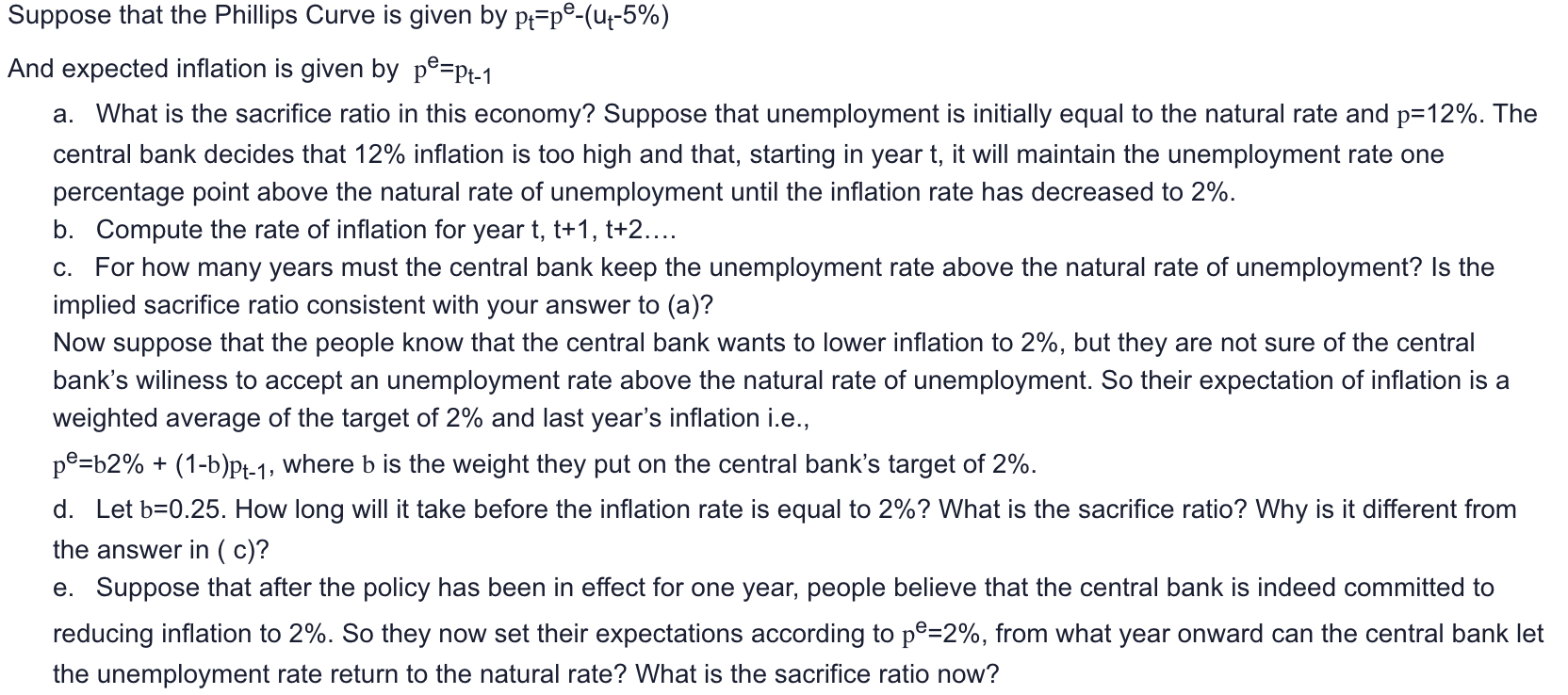
Suppose that the Phillips Curve is given by pt=pe(ut5%) And expected inflation is given by pe=pt1 a. What is the sacrifice ratio in this economy? Suppose that unemployment is initially equal to the natural rate and p=12%. The central bank decides that 12% inflation is too high and that, starting in year t, it will maintain the unemployment rate one percentage point above the natural rate of unemployment until the inflation rate has decreased to 2%. b. Compute the rate of inflation for year t,t+1,t+2 c. For how many years must the central bank keep the unemployment rate above the natural rate of unemployment? Is the implied sacrifice ratio consistent with your answer to (a)? Now suppose that the people know that the central bank wants to lower inflation to 2%, but they are not sure of the central bank's wiliness to accept an unemployment rate above the natural rate of unemployment. So their expectation of inflation is a weighted average of the target of 2% and last year's inflation i.e., pe=b2%+(1b)pt1, where b is the weight they put on the central bank's target of 2%. d. Let b=0.25. How long will it take before the inflation rate is equal to 2% ? What is the sacrifice ratio? Why is it different from the answer in (c)? e. Suppose that after the policy has been in effect for one year, people believe that the central bank is indeed committed to reducing inflation to 2%. So they now set their expectations according to pe=2%, from what year onward can the central bank let the unemployment rate return to the natural rate? What is the sacrifice ratio now? Suppose that the Phillips Curve is given by pt=pe(ut5%) And expected inflation is given by pe=pt1 a. What is the sacrifice ratio in this economy? Suppose that unemployment is initially equal to the natural rate and p=12%. The central bank decides that 12% inflation is too high and that, starting in year t, it will maintain the unemployment rate one percentage point above the natural rate of unemployment until the inflation rate has decreased to 2%. b. Compute the rate of inflation for year t,t+1,t+2 c. For how many years must the central bank keep the unemployment rate above the natural rate of unemployment? Is the implied sacrifice ratio consistent with your answer to (a)? Now suppose that the people know that the central bank wants to lower inflation to 2%, but they are not sure of the central bank's wiliness to accept an unemployment rate above the natural rate of unemployment. So their expectation of inflation is a weighted average of the target of 2% and last year's inflation i.e., pe=b2%+(1b)pt1, where b is the weight they put on the central bank's target of 2%. d. Let b=0.25. How long will it take before the inflation rate is equal to 2% ? What is the sacrifice ratio? Why is it different from the answer in (c)? e. Suppose that after the policy has been in effect for one year, people believe that the central bank is indeed committed to reducing inflation to 2%. So they now set their expectations according to pe=2%, from what year onward can the central bank let the unemployment rate return to the natural rate? What is the sacrifice ratio now







